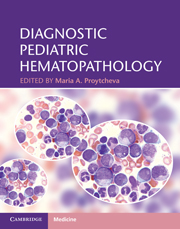Book contents
- Frontmatter
- Contents
- List of contributors
- Acknowledgements
- Introduction
- Section 1 General and non-neoplastic hematopathology
- Section 2 Neoplastic hematopathology
- 10 Chromosome abnormalities of hematologic malignancies
- 11 Expression profiling in pediatric acute leukemias
- 12 Myeloproliferative neoplasms
- 13 Myelodysplastic/myeloproliferative neoplasms
- 14 Myelodysplastic syndromes and therapy-related myeloid neoplasms
- 15 Acute myeloid leukemia and related precursor neoplasms
- 16 Hematologic abnormalities in individuals with Down syndrome
- 17 Precursor lymphoid neoplasms
- 18 Advances in prognostication and treatment of pediatric acute leukemia
- 19 The effect of chemotherapy, detection of minimal residual disease, and hematopoietic stem cell transplantation
- 20 Pediatric small blue cell tumors metastatic to the bone marrow
- 21 Pediatric mature B-cell non-Hodgkin lymphomas
- 22 Pediatric mature T-cell and NK-cell non-Hodgkin lymphomas
- 23 Hodgkin lymphoma
- 24 Immunodeficiency-associated lymphoproliferative disorders
- 25 Histiocytic proliferations in childhood
- 26 Cutaneous and subcutaneous lymphomas in children
- Index
- References
19 - The effect of chemotherapy, detection of minimal residual disease, and hematopoietic stem cell transplantation
from Section 2 - Neoplastic hematopathology
Published online by Cambridge University Press: 03 May 2011
- Frontmatter
- Contents
- List of contributors
- Acknowledgements
- Introduction
- Section 1 General and non-neoplastic hematopathology
- Section 2 Neoplastic hematopathology
- 10 Chromosome abnormalities of hematologic malignancies
- 11 Expression profiling in pediatric acute leukemias
- 12 Myeloproliferative neoplasms
- 13 Myelodysplastic/myeloproliferative neoplasms
- 14 Myelodysplastic syndromes and therapy-related myeloid neoplasms
- 15 Acute myeloid leukemia and related precursor neoplasms
- 16 Hematologic abnormalities in individuals with Down syndrome
- 17 Precursor lymphoid neoplasms
- 18 Advances in prognostication and treatment of pediatric acute leukemia
- 19 The effect of chemotherapy, detection of minimal residual disease, and hematopoietic stem cell transplantation
- 20 Pediatric small blue cell tumors metastatic to the bone marrow
- 21 Pediatric mature B-cell non-Hodgkin lymphomas
- 22 Pediatric mature T-cell and NK-cell non-Hodgkin lymphomas
- 23 Hodgkin lymphoma
- 24 Immunodeficiency-associated lymphoproliferative disorders
- 25 Histiocytic proliferations in childhood
- 26 Cutaneous and subcutaneous lymphomas in children
- Index
- References
Summary
Introduction
As a result of combination chemotherapy administered from several months to 2–3 years, depending upon the type of malignancy and risk stratification, the cure rate in children with acute lymphoblastic leukemia (ALL) who are younger than 15 years of age has risen from less than 10% in the pre-chemotherapy era to 88% presently [1]. Moreover, the cure rate for acute myeloid leukemia (AML), although not as successful, has also markedly improved. This success came mostly as a result of randomized clinical trials conducted by the Children's Oncology Group (COG), the St. Jude Children's Research Hospital, the Medical Research Council in the United Kingdom, and the German Berlin–Frankfurt–Münster clinical trials group. However, while the chemotherapy is necessary for a cure, most of the chemotherapeutic agents have serious myelosuppressive effects resulting in short- and long-term abnormalities in the peripheral blood and bone marrow. Knowledge of these changes is essential for the proper evaluation of such specimens in children undergoing chemotherapy.
Factors affecting treatment response
The treatment response and leukemia clearance differ depending on multiple factors associated with the host response to chemotherapy. Recent studies have shown that these differences in response to drugs are due to individual genomic variations such as single nucleotide polymorphisms (SNPs), insertion, inversions, copy-number variations, epigenetic variants, or loss of heterozygosity that are able to influence the absorption, distribution, metabolism, and excretion of chemotherapeutic agents [2] (Table 19.1 [3]).
- Type
- Chapter
- Information
- Diagnostic Pediatric Hematopathology , pp. 357 - 378Publisher: Cambridge University PressPrint publication year: 2011



